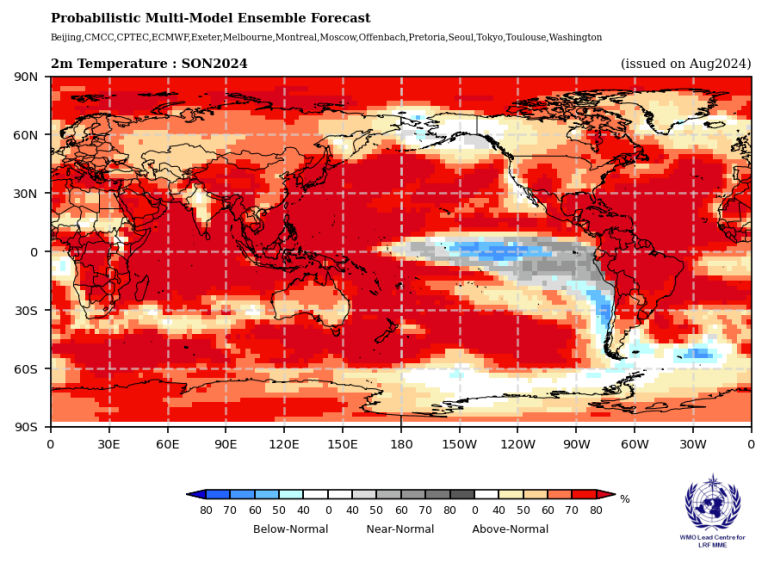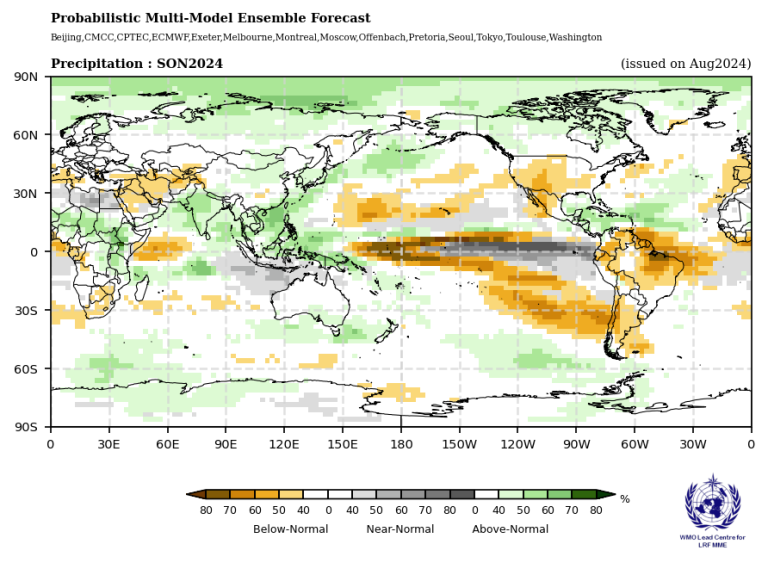During May-July, the Pacific Niño sea-surface temperature (SST) index in the eastern Pacific (Niño 1+2) declined into below-normal territory. Of the other three Niño indices only the Niño 4, the westernmost index, stayed above normal while SST conditions in the equatorial central and eastern Pacific were in the ENSO-neutral condition. The observed Indian Ocean Dipole (IOD) was near-zero. Both the North Tropical Atlantic (NTA) and South Tropical Atlantic (STA) SST indices were above-normal and reflected widespread warmth in the tropical Atlantic. In general, the observed SST anomalies in global oceans were positive1.
Above-normal sea-surface temperature anomalies in the Niño 3.4 and Niño 3 regions are predicted to decline during September-November 2024 and are predicted to reach weak La Niña conditions. Farther west in the Niño 4 region, the sea-surface temperature anomaly is predicted to be near-normal. The strength of the Indian Ocean Dipole (IOD) index is also predicted to return to near normal. In the equatorial Atlantic, SSTs are predicted to be above-normal in both the northern (NTA) and the southern (STA) areas during the season with larger values positive anomalies for NTA.
Consistent with the anticipated persistence of widespread above-normal sea-surface temperatures in all ocean basins outside of the near-equatorial eastern Pacific Ocean, there is widespread prediction of above-normal temperatures over almost all land areas. Exceptions to this widespread warmth are South America south of about 40º S, the south-western coast of North America and in the vicinity of the Bering Sea, and the interior western region of the Indian subcontinent. Extensive areas of large increases in probabilities for above-normal temperatures include almost all of Africa, and within about 45º N of the equator over Europe, south of 45º N over Asia, and within about 25º over Northern, Central and South America and the Caribbean. Northern Australia, New Zealand, and most of the islands in the South Pacific have moderate to strongly increased probabilities for above-normal temperatures. North of about 60º N, North America, Europe and Asia have weak to moderately increased probabilities for above-normal temperature. In coastal areas of southern South America and extending north along the west coast to just north of the equator and into the eastern Pacific, below-normal temperatures are expected, consistent with the predicted emergence of weak La Niña conditions.


Predictions for rainfall are, in part, similar to the impacts of the early stages of La Niña, which is expected to emerge during September-November 2024. Enhanced probabilities for near- or below-normal rainfall are predicted over a narrow band along or just north and south of the equator extending eastward from 150º E to the southern region of Central America. There are additional bands of prediction for enhanced probabilities for below-normal rainfall spanning the width of the Pacific. The Northern Hemisphere band located around 30º N extends into north-western Central America and the south-western part of North America. The Southern Hemisphere band is more extensive, extending to cover a wide swath of western coast of South America centred around 30º S and then across into the South Atlantic. Probabilities for above-normal rainfall are moderately enhanced over the central and eastern Maritime Continent. Over Africa, between about 10º and 25º N and east of 0º, there are increased probabilities for above-normal rainfall. These probabilities strengthen towards the east where the area of above-normal rainfall probability dips southward to reach 15º S. The probabilities for above-normal rainfall are enhanced over the Indian subcontinent which to the east extends all the way to Southeast Asia and then extends northward along the coastal regions of East Asia. To the west, there is enhancement in probabilities for below-normal rainfall over Central Asia extending into the Arabian Peninsula. Over South America, except for a few regions in the interior of the continent extending from the west coast to the east coast where there is no clear signal, almost all South America has increased probabilities for below-normal rainfall. Probabilities for above-normal rainfall are weakly enhanced over an area that extends from southern Central America over to most of the Caribbean. A region of enhanced probability for below-normal rainfall is predicted over the interior and southern regions of North America west of 90º W with regions of stronger probability located over the southwest crossing into northern Central America. For most of Europe there is no clear signal.






